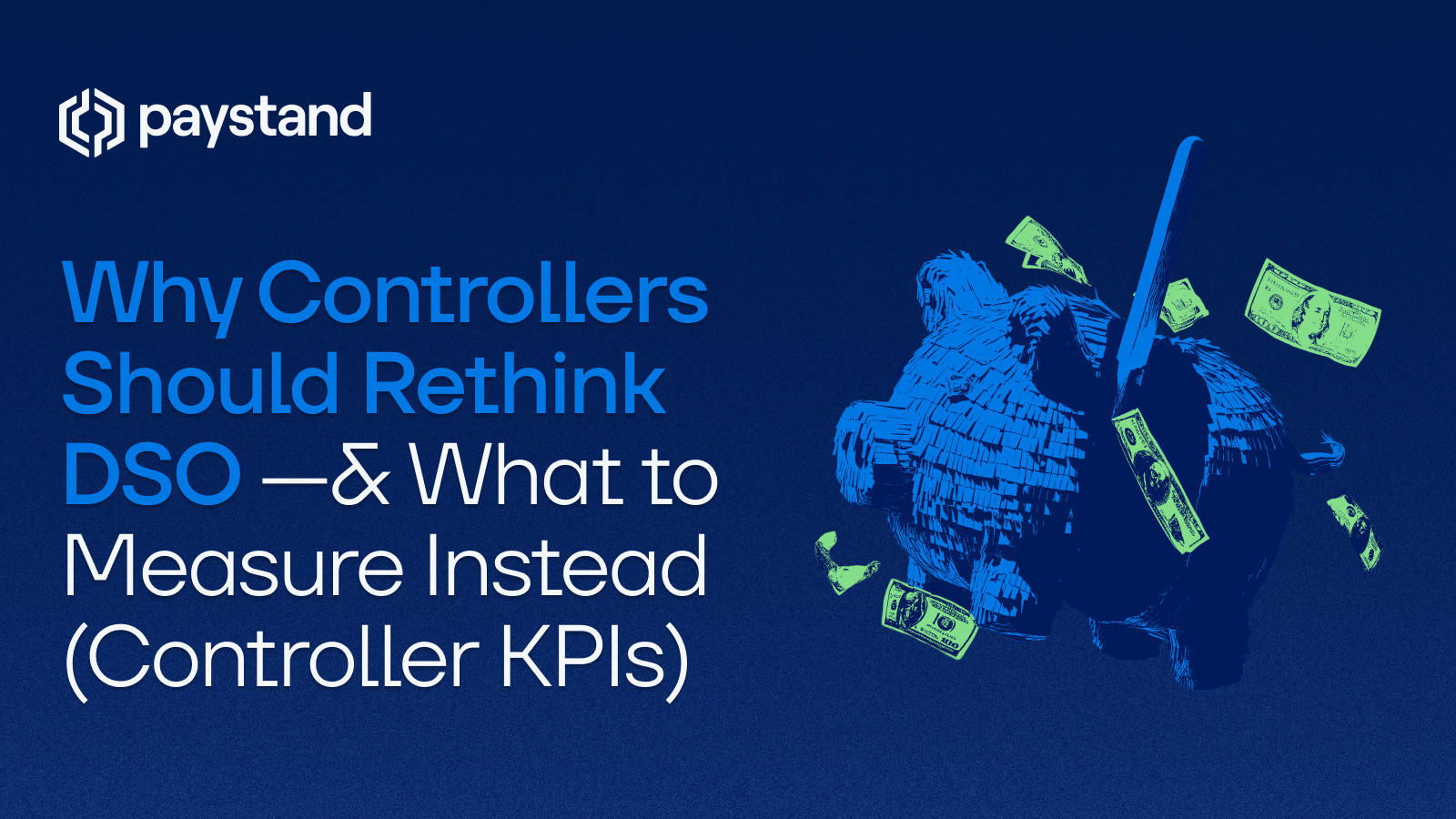Why Controllers Should Rethink DSO—& What to Measure Instead (Controller KPIs)

Table of Contents
- The (Very Real) Limits of DSO
- The Upgraded KPI Stack for Controllers
- What to Show Your CFO (and Board)
- Implementation: 90 Days to a Better Metric System
- A Note on Accounts Payable and Cross-Team Alignment
Key Takeaways
- DSO isn’t dead—but it’s incomplete. It’s directional, not diagnostic.
- Controllers need operating KPIs like WADC, CEI, AR Turnover, and ADD to see what’s happening now, not last quarter.
- WADC reveals large-account slowdowns early; CEI measures team throughput; ADD flags delays before DSO moves.
- A 30/60/90 plan (visibility → standardization → automation) modernizes your KPI system without adding headcount.
- Dashboards beat decks: Weekly metrics + monthly narratives give CFOs and boards real insight into working capital.
- Controller KPIs connect AR to FP&A and Treasury, aligning operations with profitability and cash strategy.
For Controllers, Days Sales Outstanding (DSO) offers familiarity and comparability, but it’s a lagging indicator. It hides mix shifts, ignores disputes, and doesn’t reveal where cash actually gets stuck. To keep pace with hybrid billing models and tighter working capital goals, Controllers need KPIs that reflect real-time operations—not just past performance.
This guide breaks down the Controller KPIs that actually move cash: WADC, CEI, AR Turnover, and ADD—plus how to build a board-ready dashboard and implement a 90-day plan to modernize your metric stack.
DSO is useful—until it isn’t
Days Sales Outstanding (DSO) has earned its place in board decks. It’s comparable and directional, and every Controller knows it cold. But DSO has blind spots that can mislead CFOs and controllers—especially in hybrid invoicing models (recurring + milestones) or when sales mix shifts.
If your team is optimizing to “make DSO look good,” you might miss the key performance indicators (KPIs) that actually move cash flow, profit margins, and working capital.
The (very real) limits of DSO
- Sales mix distortion: A big enterprise invoice can mask long-tail slippage.
- Backward-looking bias: DSO measures history; it doesn’t show current bottlenecks in collection processes.
- Policy changes: If you tighten payment terms mid-quarter, DSO won’t reflect the improvement for weeks.
Controller KPIs should connect real-time operating signals to financial performance—so you can intervene before cash stalls.
The upgraded KPI stack for Controllers
1. WADC (Weighted Average Days to Collect)
Why Controllers love it: It weighs by invoice size, so large-account delays show up immediately.
Tie-in to financials: Faster WADC improves short-term cash flow and reduces reliance on external financing, protecting net income from interest drag.
Move the number:
- Add sales-assist to the cadence at Day 30 and Day 60.
- Require milestone evidence before billing (reduces disputes that push WADC out).
2. CEI (Collections Effectiveness Index)
What it answers: “How much collectible AR did we collect payments on this period?”
Controller lens: CEI is a pure operating KPI—great for weekly standups and the accounting team’s throughput.
Move the number:
- Close the loop on dispute codes (pricing, PO mismatch, delivery).
- Automate statements + reminders; schedule a cross-functional AR Council to unblock issues in real time.
3. AR Turnover Ratio
Formula: turnover ratio net credit sales ÷ average accounts receivable.
Why it matters: Ties AR to the income statement—fast turnover supports growth rate without starving working capital.
Move the number:
- Segment by product/industry to see where operational efficiency lags.
- For the percentage of high-risk accounts, require deposits or smaller initial orders (“start small, monitor, then scale”).
4. Average Days Delinquent (ADD)
Why Controllers track it: It’s the earliest alarm when customers don’t pay on time, even if DSO looks stable.
Finance link: Rising ADD elongates the cash conversion cycle, squeezing financial health and cost savings targets.
Move the number:
- Tighten reminder intervals (7/15/30) and add a Day-45 phone call.
- Publish a Top-10 “red list” (balance, delinquency, owner, next step) for weekly leadership read-out.
5. Forward Cash Signal KPIs (Controller → FP&A handshake)
- 13-week cash forecast accuracy using DSO/WADC glide paths.
- Unapplied cash (% of AR).
- Dispute backlog (count, days open, $$).
These “nowcasts” connect AR operations to real-time liquidity and budget variances—the bridge from process to financial success.
What to show your CFO (and board)
A. Controller’s weekly dashboard
- DSO (current + 4-week trend)
- WADC (current + 4-week trend)
- Aging by bucket (0–30/31–60/61–90/90+)
- CEI and ADD
- Top-10 accounts (balance, last payment, owner, next action)
- Unapplied cash and exceptions
B. Monthly narrative (1 slide, 6 bullets)
- Where DSO/WADC moved and why
- CEI + ADD (cadence and dispute outcomes)
- Percentage of high-risk accounts and terms changes
- Collections automation progress (reminders, cash app matching)
- Sales-assist escalations and results
- Next month's risks & mitigations
Implementation: 90 days to a better metric system
30 days – Build visibility
- Stand up WADC + CEI + ADD alongside DSO.
- Map your AR process from quote → invoice → reminder → cash app → reconciliation; label where delays occur.
- Start the baseline collections cadence and verify bank-change call-backs.
60 days – Standardize
- Lock Terms/Credit Policy (default Net 30; deposits for projects).
- Launch the AR Council (Controller/CFO, AR lead, Sales/CS, Ops).
- Publish weekly dashboard + Top-10 watchlist.
90 days – Automate
- Automate invoicing, reminders, and matching; cut unapplied cash to <2% of AR.
- Add Controller KPIs to BI with alerts (WADC/CEI threshold breaches).
- Release your first AR Health Scorecard to leadership.
A note on accounts payable and cross-team alignment
Great Controller KPIs don’t live in a silo. Share WADC/CEI/ADD with FP&A to improve forecast quality, with Treasury to optimize cash positioning, and with AP to time outflows against inflows. That’s how financial performance translates into sustained profit that a company can reinvest.
Keep DSO—but stop depending on it. Modern Controller KPIs blend DSO with WADC, CEI, AR turnover ratio, and ADD to give you a real-time read on cash flow, operational efficiency, and financial health. When you pair those measures with standard policies, cross-functional escalation, and targeted automation, you get faster cash and stronger profit margins—without adding headcount.
Looking for the full webinar? Check out “From Aging to Cash: The Playbook to Accelerate Collections.”
Take a deep dive into the metrics and the 30/60/90 rollout in the ebook: "The Playbook to Accelerate Collections"







%20(1)%20(1).jpg?width=100&height=100&name=IMG_3752%20(1)%20(1)%20(1).jpg)